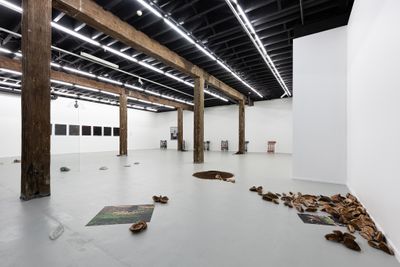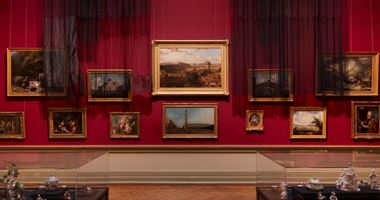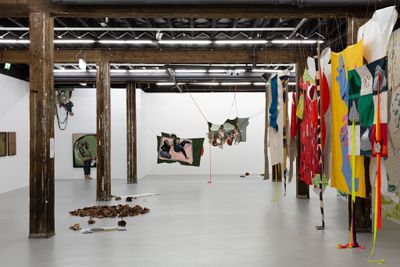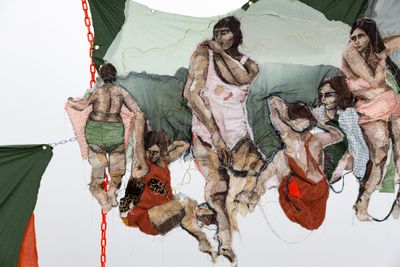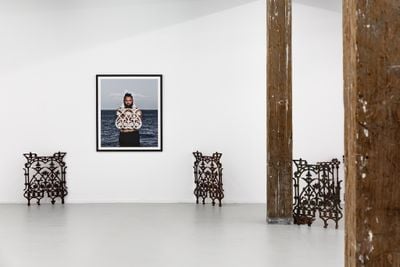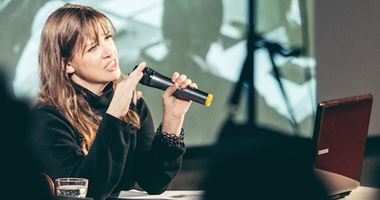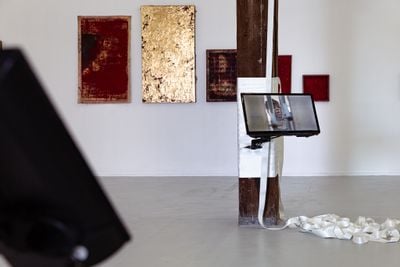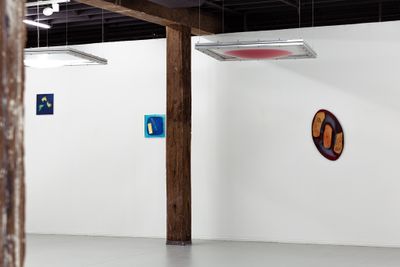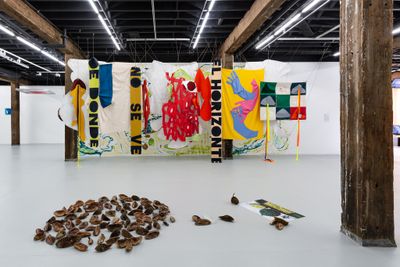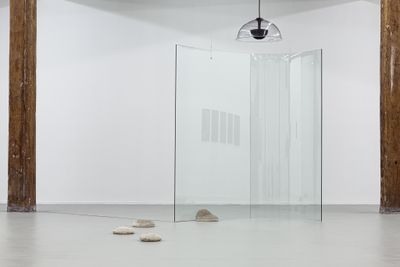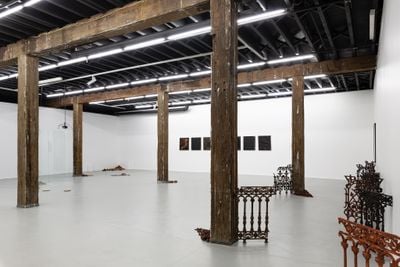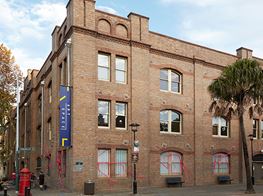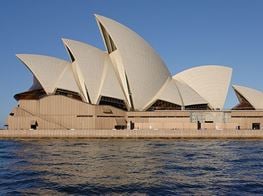Rethinking Care for the 2020 NSW Visual Arts Emerging Fellowship
In Partnership with Artspace
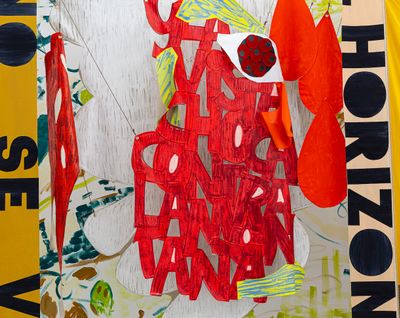
Nadia Hernández, De donde no se ve el horizonte y la vista choca contra la montaña / from where you can't see the horizon and sight collides with the mountain (2020) (detail). Exhibition view: 2020 NSW Visual Arts Emerging Fellowship, Artspace, Sydney (14 March–8 June 2020). Courtesy Artspace. Photo: Document.
The etymology of the word curator comes from the Latin cūrāre, or 'to care for'. While historical models of curating often relate to the care of objects and collections, it is now widely acknowledged that contemporary curatorial methodologies include the care of artists, audiences, communities, ideas, and culture.
At its most utopian, care has been positioned as a radical act of resistance against late-capitalist productivity, individualism, and the rise of neo-fascism.1 This year, the term infiltrated our everyday interactions, particularly during the beginning of the Covid-19 pandemic, as we ended our phone calls and signed off emails with the humble 'take care': a small gesture of intimacy and kindness against the chaos of the outside world.
There is very little about 2020 that could be considered business as usual, not least the process of planning an exhibition during a global crisis. While Covid-19 has impacted all facets of our lives, we are also bearing witness to profound and necessary social change.
Against the backdrop of a series of existential disasters, to which New South Wales has not been immune—from devastating bushfires to health and economic crises triggered by the pandemic and shutdown—a wave of global protests arose, calling for racial justice and demanding radical institutional change.
During moments such as these, there is the rare opportunity to take pause, reflect, and rethink ways of working that are rooted in a framework of empathy, care, and ethics. Just one week prior to the implementation of health restrictions in New South Wales, Artspace hosted a party for the opening of NIRIN the 22nd Biennale of Sydney (14 March–8 June 2020), with hundreds of people gathering together in celebration and embracing, kissing cheeks, even dancing—activities that are now shadows of a past life.
The distancing of bodies in space has profoundly changed our interactions with one another. While of course necessary and practical, social distancing will be embedded in the way we behave in and engage with art galleries for the foreseeable future.
Now, more than ever, exhibitions must be designed with audiences in mind. This means not only considering personal and collective safety, but accommodating anxieties about enclosed or 'black box' rooms. It's a unique challenge for curators aiming to balance the integrity of artworks with audience expectations and ever-fluctuating government regulations.
In recent decades, the 'tyranny of distance' of Australia's remoteness was a relic of the pre-globalised world. Covid-19 has brought a new perspective to the notion of distance for our island country; one that reminds us of the importance of looking inwards as much as looking out. During this time, our focus has been to support our local artist communities and advocate for the strength, diversity, and resilience of Australia's cultural sectors.
It was during this national re-focus that we received the list of finalists for the 2020 NSW Visual Arts Emerging Fellowship (NSWVAEF), an annual exhibition held at Artspace that highlights artistic practice from early career artists across the state.
At first it felt like an impossible task to work towards a physical exhibition in the gallery—were we going to reopen our doors to the public and, when we did, what would that even look like? It was evident to us that the development of this exhibition would not compare with previous years. We saw it as an opportunity to work closely with each artist and take steps to embed care across the production and presentation of the exhibition.
At its most fundamental, care has the capacity to transform the power dynamics between artists and institutions by building relationships that support one another. As Kate Fowle, the director of MoMA PS1 in New York, argues in her eponymous essay 'Who cares? Understanding the Role of the Curator Today', we must embrace an expanded field of curatorial practice to allow for more complex and nuanced exchanges between artists and curators.2
While the word care is commonly used, sometimes overused, in the art world, it's important that we reclaim it as a verb through action and practice.
As curators, we work to reflect the world around us, and given that the world currently feels exposed and unstable, it provided a clear intention with which to approach this year's Fellowship—with a deep sense of empathy and openness. We launched into the project by cultivating the conditions for trust with the artists, firstly between themselves as peers, and secondly with us as curators.
Working in close collaboration, we were guided by the eight finalists—Akil Ahamat, Tarik Ahlip, Tiyan Baker, Kate Brown, Dennis Golding, Julia Gutman, Nadia Hernández, and Kirtika Kain—to jointly shape the NSWVAEF exhibition. Our aim was to build capacity for each of the artists by working together in a supportive and transparent environment.
At its most fundamental, care has the capacity to transform the power dynamics between artists and institutions by building relationships that support one another.
With over 100 years of history, the Fellowship is one of the oldest art prizes in Australia and a key exhibition for profiling the dynamism and breadth of emerging contemporary artistic practice in New South Wales. Valued at AUD $30,000, this Fellowship is offered by the NSW Government through Create NSW to enable a visual artist at the beginning of their career to undertake a self-directed programme of professional development. The finalist exhibition has been held annually at Artspace since 1997, continuing to define new generations of contemporary art practice for both artists and audiences.
Over the past seven years, Artspace has been working to redefine and reimagine the evolution of this historic award. It now offers a critical opportunity for professional development for emerging artists through curatorial advocacy and mentorship. This year, we employed the digital infrastructures that continue to proliferate throughout the pandemic to connect artists in more ways.
With the uncertainty of what would happen over the coming months, we created a series of contingency plans and timelines that aimed to predict all possible scenarios. In addition, we instituted a curatorial model we colloquially call 'zero to one hundred', reflecting a scale from doing nothing to being prepared for everything, hoping to land on middle ground somewhere along the way.
There were also practical considerations of exhibition-making, such as how to present sound or moving-image work without the use of headphones, and how to refrain from building separate spaces that restrict the movement of audiences. Rather than creating secularised environments for each artist, we decided to curate the exhibition where the proximity between artists' works allow them to make contact or contaminate one another through sound bleed, lighting, or sight lines.
We opened up the architecture by knocking down all temporary walls and painting the entire gallery back to white. Many artists worked in multiples that extend and detour across the gallery, adding texture to the exhibition and allowing audiences to generate accumulative relationships to artworks and ideas as they move through the space.
Working with this generation of voices has offered unique insight into how artists are continuing to maintain their practice during this time. It was particularly encouraging that each finalist took ambitious risks by working with new materials or expanding their work through scale and ideas, which is completely at odds with the overwhelming sense of fortification and doubling down that might be expected given the competitive aspect of the award and the broader mood of 2020.
All works are new and site-specific, directly interrupting or playing with the architecture of the gallery. Artworks make contact with one another and interrupt sightlines in an intentional gesture informed by a desire to find connection, entanglement, and contact.
Across the exhibition, artists share a sensibility for material transformation, reinterpreting the meaning of objects and imagery through time. Themes of accumulation, repetition, and memory span the exhibition as artists create replicas, collages, and readymades hybridised from original sources. For artists such as Dennis Golding and Tiyan Baker, the act of reproduction is concerned with embedding and empowering objects—many of which are loaded with the enduring effects of history and power.
Nadia Hernández and Julia Gutman collaborated with family, friends, and the wider community to find shared stories of identity and lived experiences. By revealing these interpersonal relationships, they negotiate the politics of vulnerability and empathy as a method of healing through grief. While deeply rooted in the histories of material practice, Kirtika Kain employs written and visual languages to think through culture and connection, as well as their loss over time.
Tarik Ahlip and Akil Ahamat play with the utility and poetics of technologies to create speculative spaces and to imagine potential futures. Kate Brown uses technology to evoke spaces of the body that are both seen and unseen. The body resonates across the gallery, tracing encounters and intimacies between artists and audiences.
On the eve of the exhibition opening, it's been a useful exercise to reflect on curating the NSWVAEF exhibition during the peak of Covid-19 in Australia. Writing this piece has served as a reminder that the responsibility of the interpersonal is a critical part of curatorial practice.
Curating isn't about connoisseurship, but rather the necessity facilitation of cultural experiences that are embedded in principles of care. While the shutdown allowed for a moment of pause and reflection, time is again accelerating. It's important to hold on to the learnings from this year and continue to grow alongside the schisms and ruptures of the world around us.
As Arundhati Roy reasons in her Financial Times essay 'The pandemic is a portal', rather than going back to 'normalcy' we can shed the things we no longer desire and imagine the world anew.3 So while we eventually want a return to our bombastic opening parties filled with sweaty bodies in proximity to one another, we have the autonomy to decide which parts of the pre-Covid world no longer serve us. In the meantime, we will continue to share risky ideas in safe spaces.—[O]
The announcement of the recipient of the 2020 NSWVAEF will be livestreamed on Thursday 12 November at 5:45pm AEDT. Register here.
__
1 'Ante-Scriptum', Rebecca Jagoe & Sharon Kivland (eds), ON CARE, Ma Bibliotèque, London, 2020, p.12.
2 Kate Fowle, 'Who Cares? Understanding the Role of the Curator Today', in Steven Rand and Heather Kouris (eds), Cautionary Tales: Critical Curating, apexart, New York, 2007, p.18.
3 Arundhati Roy, 'The pandemic is a portal', Financial Times, 4 April 2020, ft.com/content/10d8f5e8-74eb-11ea-95fe-fcd274e920ca, accessed 1 November 2020.

